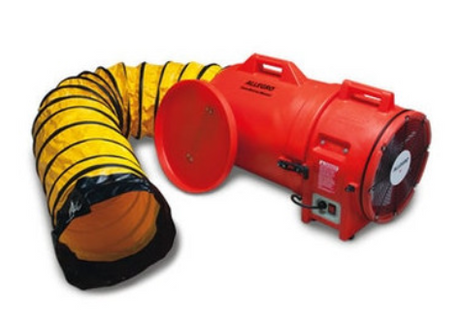Confined Space Entry – What to Take When You Go
There are some tools and equipment that anyone performing confined space entry must have to ensure the safety of their workers. Whether your company has determined that confined space procedures need to be developed for your on-site hazards, or if you are a contractor performing a one-time job, equipment such as a gas detector, ventilation fan, harness, tripod and winch will be essential for you or your worker’s safety.
Gas monitors are used to test the atmosphere before entry into the confined space. Gas detectors are either diffusion monitors which sample the air the unit comes in contact with, or they are monitors with an internal pump which can pull air from the areas to be entered. Diffusion pumps often have the option to purchase a hand pump that can manually pull air to the unit.
Axial fans are often used to ventilate confined spaces before or during confined space entry. Axial fans push or pull air horizontally and are often hooked to ducting to move air to or from a specific area. Most often, good air is pushed into a confined space prior to entry if the air quality is less than desired. This process is called supply ventilation or positive-pressure ventilation.
The harness, tripod and winch combination are important for getting an incapacitated worker out of a confined space. The winch must be man-rated which means obviously that it is strong enough to pull someone weighing up to 320 pounds, when properly set up, out of a space. They come with various lengths of wire, and with different materials to suit the type of work you are doing. Some corrosive or marine environments, for example, might be better off with stainless steel components. Others may be fine with galvanized wire.
Tripods, or more versatile davit systems, create an overhead attachment point for the winch line to be centered over the confined space entry point. The wire is generally attached to a carabiner and pulley system at the apex of the tripod, the worker is attached on the back of the harness to the cable with a double-locking hook and lowered, or allowed to climb, down into the confined space.
Harnesses have a huge range of price and function. Generally the less expensive ones are less comfortable, and anyone working for extended times in a harness would want to consider spending the extra money for the added wearability. Harnesses for confined space entry will have a d-ring or other attachment point on the back between the shoulder blades. Additionally, they may come with positioning rings and equipment hooks to facilitate the work being done within the confined space.
Confined space entries are never routine. Even a space that has been entered safely many times in the past can accumulate deadly gases and put an undisciplined crew at risk. Low oxygen levels, gas leaks, and toxic fumes are hazards that can quickly and unexpectedly overcome an unprotected or incautious worker.
Because of the dangers inherent in confined spaces, the Occupational Health and Safety Administration (OSHA) created the " permit required" confined space regulation.
Confined spaces are areas large enough to enter, but access to the space is physically limited or restricted. They are large enough to work in, but are not designed for continuous use. Confined spaces can include tank, storage bins, hoppers, vaults, and pits. There are a number of dangers inherent in working in these types of spaces. These include: hazardous atmospheres containing flammable or toxic gases or vapors, too little or too much oxygen, or tight areas that where lingering atmospheric dangers can trap and incapacitate workers.
Failure to follow the safety standards set out by OSHA is an invitation to serious injury or even death. There is no room for risk in confined space entry. Each job must be approached with a professional attitude, and a methodical procedure designed to prevent dangerous situations from escalating into life-threatening situations.
There are ways to make confined spaces safer. Regulations are in place to help workers recognize that confined spaces are a potential problem and a hazard for workers. Confined spaces must be sought out on a property or plant. The first step is to figure out what they are, and where they are. Next it is imperative to get someone who is very qualified to come in and assess the risks of those spaces and help provide procedures and protocols for entry into the spaces.
Recent Posts
-
The Best Cold Weather Gloves for Package Handlers and Delivery Drivers | PK Safety
Best Gloves for Package Handlers During the Holiday Season As the holiday season approaches, pa …Nov 11th 2024 -
Why Hi-Vis Winter Work Gear is Essential for Safety During the Cold Months | PK Safety
When temperatures drop and daylight hours shrink, outdoor workers face additional hazards that incre …Oct 31st 2024 -
Self Braking Descender: Advanced Rope Control for Fall Protection | PK Safety
For professionals working at heights, controlled descent is critical. Whether you’re a window cle …Oct 30th 2024





